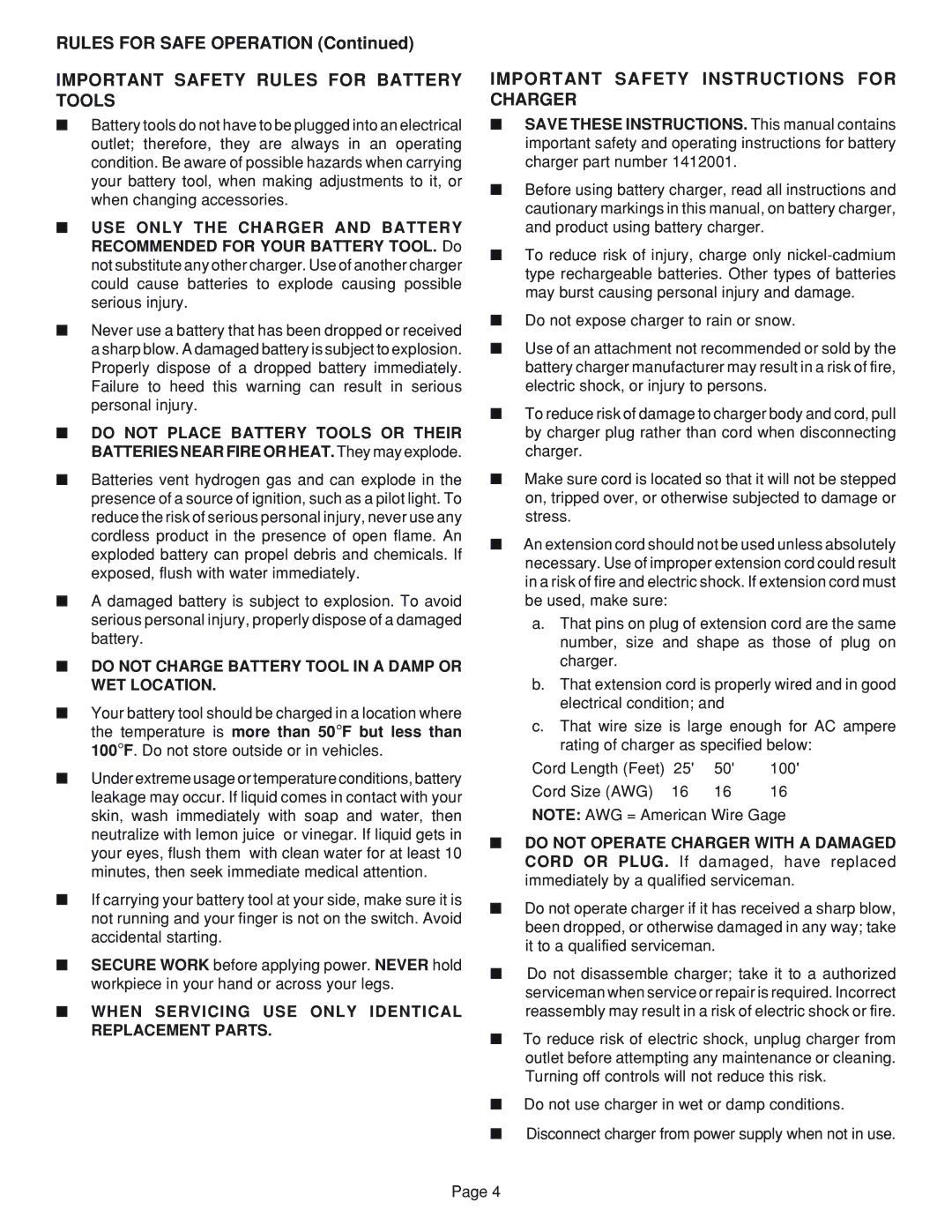RULES FOR SAFE OPERATION (Continued)
IMPORTANT SAFETY RULES FOR BATTERY TOOLS
■Battery tools do not have to be plugged into an electrical outlet; therefore, they are always in an operating condition. Be aware of possible hazards when carrying your battery tool, when making adjustments to it, or when changing accessories.
■USE ONLY THE CHARGER AND BATTERY RECOMMENDED FOR YOUR BATTERY TOOL. Do not substitute any other charger. Use of another charger could cause batteries to explode causing possible serious injury.
■Never use a battery that has been dropped or received a sharp blow. A damaged battery is subject to explosion. Properly dispose of a dropped battery immediately. Failure to heed this warning can result in serious personal injury.
■DO NOT PLACE BATTERY TOOLS OR THEIR BATTERIES NEAR FIRE OR HEAT. They may explode.
■Batteries vent hydrogen gas and can explode in the presence of a source of ignition, such as a pilot light. To reduce the risk of serious personal injury, never use any cordless product in the presence of open flame. An exploded battery can propel debris and chemicals. If exposed, flush with water immediately.
■A damaged battery is subject to explosion. To avoid serious personal injury, properly dispose of a damaged battery.
■DO NOT CHARGE BATTERY TOOL IN A DAMP OR WET LOCATION.
■Your battery tool should be charged in a location where the temperature is more than 50°F but less than 100°F. Do not store outside or in vehicles.
■Under extreme usage or temperature conditions, battery leakage may occur. If liquid comes in contact with your skin, wash immediately with soap and water, then neutralize with lemon juice or vinegar. If liquid gets in your eyes, flush them with clean water for at least 10 minutes, then seek immediate medical attention.
■If carrying your battery tool at your side, make sure it is not running and your finger is not on the switch. Avoid accidental starting.
■SECURE WORK before applying power. NEVER hold workpiece in your hand or across your legs.
■WHEN SERVICING USE ONLY IDENTICAL REPLACEMENT PARTS.
IMPORTANT SAFETY INSTRUCTIONS FOR CHARGER
■SAVE THESE INSTRUCTIONS. This manual contains important safety and operating instructions for battery charger part number 1412001.
■Before using battery charger, read all instructions and cautionary markings in this manual, on battery charger, and product using battery charger.
■To reduce risk of injury, charge only
■Do not expose charger to rain or snow.
■Use of an attachment not recommended or sold by the battery charger manufacturer may result in a risk of fire, electric shock, or injury to persons.
■To reduce risk of damage to charger body and cord, pull by charger plug rather than cord when disconnecting charger.
■Make sure cord is located so that it will not be stepped on, tripped over, or otherwise subjected to damage or stress.
■An extension cord should not be used unless absolutely necessary. Use of improper extension cord could result in a risk of fire and electric shock. If extension cord must be used, make sure:
a.That pins on plug of extension cord are the same number, size and shape as those of plug on charger.
b.That extension cord is properly wired and in good electrical condition; and
c.That wire size is large enough for AC ampere rating of charger as specified below:
Cord Length (Feet) | 25' | 50' | 100' |
Cord Size (AWG) | 16 | 16 | 16 |
NOTE: AWG = American Wire Gage
■DO NOT OPERATE CHARGER WITH A DAMAGED CORD OR PLUG. If damaged, have replaced immediately by a qualified serviceman.
■Do not operate charger if it has received a sharp blow, been dropped, or otherwise damaged in any way; take it to a qualified serviceman.
■Do not disassemble charger; take it to a authorized serviceman when service or repair is required. Incorrect reassembly may result in a risk of electric shock or fire.
■To reduce risk of electric shock, unplug charger from outlet before attempting any maintenance or cleaning. Turning off controls will not reduce this risk.
■Do not use charger in wet or damp conditions.
■Disconnect charger from power supply when not in use.
Page 4
